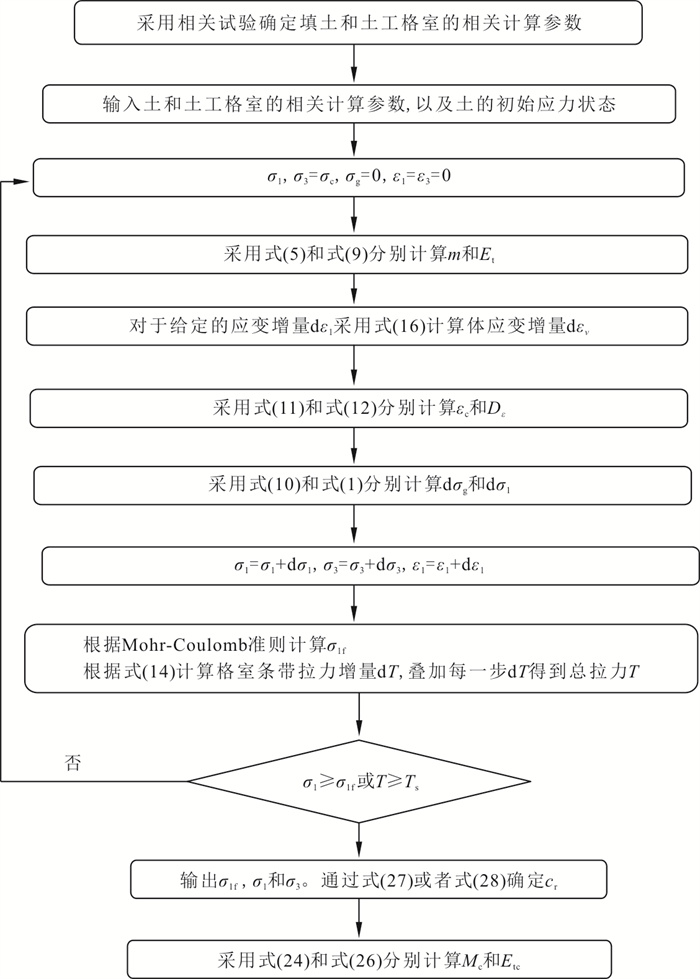-
摘要:
土工格室加筋正常固结粉质黏土对工程建设意义重大。基于土工格室与填土的相互作用机制和增量法,采用弹塑性理论、邓肯-张双曲线模型、修正剑桥屈服函数以及剪胀方程,推导了土工格室加筋正常固结黏土的应力应变响应计算模型,进行了土工格室加筋正常固结黏土的三轴固结排水剪切试验,实测不同围压下的应力应变关系,采用三轴试验结果验证了所提理论模型的正确性和可靠性。此外,采用所提理论模型进行了参数敏感分析,研究了填土的力学性质参数、格室的网格尺寸和力学性质参数对于加筋土应力应变响应的影响。研究结论表明,与砂砾料相似,土工格室约束作用对于正常固结黏土的内摩擦角影响较小,而黏聚力有所增加;随着轴向应变的增加或围压的减小,加筋效果逐渐明显;加筋正常固结黏土的强度和刚度随着非线性弹性常数
k 的增加、强度参数φ 的增加和R f的减小而增大,常数n 对于加筋土应力应变响应影响较小。本研究成果可为工程建设提供理论借鉴。Abstract:Objective The mechanical behavior of normally consolidated silty clay reinforced with geocell is of significance for engineering construction.
Methods An analytical method was formulated for the prediction of stress-strain responses in geocell-reinforced normally consolidated clay in this paper. In addition, a series of conventional triaxial compression tests were conducted on geocell-reinforced normally consolidated clay to investigate the reinforcement effects and validate the effectiveness of the proposed method. The predicted stress-strain responses are in good agreement with those measured in the tests, affirming the efficacy of the proposed method. In addition, parametric studies were conducted to investigate the effects of the mechanical properties of the backfill pocket size and the stiffness of the geocell on the stress-strain response of the geocell-reinforced clay.
Results The study results show that the geocell-reinforced normally consolidated clay exhibits strain hardening. The internal friction angle of the reinforced clay remained similar to unreinforced clay, whereas apparent cohesion increased due to geocell confinement.Furthermore, the reinforcement effect on the clay intensified with increasing axial strain and reducing confining pressure. The strength and stiffness of the reinforced clay increase with the increase in the nonlinear elastic parameter
k and the reduction inR f.Conclusion The results will be guidance for engineering construction.
-
表 1 填土主要物理性质指标
Table 1. Physical properties of the backfill used in the test
比重 液限/% 塑限/% 最优含水量/% 最大干密度/(g·cm-3) 2.67 29.5 18.1 16.0 1.66 -
[1] WEBSTER S L, WATKINS J E. Investigation of construction techniques for tactical bridge approach roads across soft ground[R]. Technical Report S-77-1, Vicksburg: U.S. Army Engineer Waterways Experiment Station, 1977. [2] REA C, MITCHELL J K. Sand reinforcement using paper grid cells[C]//Anon. Symposium on earth reinforcement. Pittsburgh: ASCE, 1978: 644-663. [3] WEBSTER S L. Investigation of beach sand traffic ability enhancement using sand-grid confinement and membrane reinforcement concepts[R]. Report 1, Sand Test Sections 1 and 2, Technical Report GL-79-20, Vicksburg: Geotechnical Laboratory, US Army Corps of Engineers Waterways Experimentation Station, 1979. [4] BATHURST R J, CROWE R E. Recent case histories of flexible geocell retaining walls in North America[C]//Tatsuoka F, Leshchinsky D, Rotterdam B. Recent case histories of permanent geosynthetic-reinforced soil retaining walls. [S. l. ]: [s. n. ], 1994: 3-19. [5] 杨晓华, 王陆平, 俞永华. 土工格室生态挡墙工程性状分析[J]. 公路交通科技, 2004(11): 23-26.YANG X H, WANG L P, YU Y H. Engineering performance analysis of geocell ecological retaining wall[J]. Journal of Highway and Transportation Research and Development, 2004(11): 23-26. (in Chinese with English abstract) [6] OKUYAMA M, AJIKI T, YAZAWA K, et al. Field observation of geocell reinforced retaining walls after the Niigataken Chuetsu-oki earthquake[J]. Geosynthetics Engineering Journal, 2007, 22: 239-242. (in Japanese) doi: 10.5030/jcigsjournal.22.239 [7] 何艳平, 张思峰, 王冠英, 等. 土工格室加固铁路软弱基床的有限元分析[J]. 山东建筑大学学报, 2008, 23(5): 431-434.HE Y P, ZHANG S F, WANG G Y, et al. FEM analysis on geocell reinforced soft subgrade of railway[J]. Journal of Shandong Jianzhu University, 2008, 23(5): 431-434. (in Chinese with English abstract) [8] XIE Y L, YANG X H. Characteristics of a new-type geocell flexible retaining wall[J]. Journal of Materials in Civil Engineering, ASCE, 2009, 21(4): 171-175. doi: 10.1061/(ASCE)0899-1561(2009)21:4(171) [9] 王启龙, 杨晓华, 晏长根. 路肩式土工格室柔性挡墙受力及变形分析[J]. 铁道科学与工程学报, 2017, 14(5): 980-987. doi: 10.3969/j.issn.1672-7029.2017.05.014WANG Q L, YANG X H, YAN C G. Analysis of the stress and deformation characteristics of geocell flexible retaining wall for subgrade shoulders[J]. Journal of Railway Science and Engineering, 2017, 14(5): 980-987. (in Chinese with English abstract) doi: 10.3969/j.issn.1672-7029.2017.05.014 [10] 孙冬旭, 李静, 兰导, 等. 微桩土工格室在生态护坡工程中的研究与应用[J]. 中外公路, 2021, 41(增刊2): 80-83.SUN D X, LI J, LAN D, et al. Research and application of micro-pile geocell in the ecological protection of slope[J] Journal of China and Foreign Highway, 2021, 41(S2): 80-83. (in Chinese with English abstract) [11] BATHURST R J, KARPURAPU R. Large-scale triaxial compression testing of geocell-reinforced granular soils[J]. Geotechnical Testing Journal, 1993, 16(3): 296-303. doi: 10.1520/GTJ10050J [12] RAJAGOPAL K, KRISHNASWAMY N R, MADHAVI LATHA G. Behavior of sand confined with single and multiple geocells[J]. Geotextiles and Geomembranes, 1999, 17(3): 171-184. doi: 10.1016/S0266-1144(98)00034-X [13] MADHAVI LATHA G, MURTHY V S. Effects of reinforcement form on the behaviour of geosynthetic reinforced sand[J]. Geotextiles and Geomembranes, 2007, 25(3): 23-32. [14] WU C S, HONG Y S. Laboratory tests on geosynthetic-encapsulated sand columns[J]. Geotextiles and Geomembranes, 2009, 27(2): 107-120. doi: 10.1016/j.geotexmem.2008.09.003 [15] CHEN R H, HUANG Y W, HUANG F C. Confinement effect of geocells on sand samples under triaxial compression[J]. Geotextiles and Geomembranes, 2013, 37(3): 35-44. [16] 陈建峰, 曾岳, 冯守中, 等. 土工织物散体桩桩体单轴压缩试验[J]. 中国公路学报, 2018, 31(6): 181-187.CHEN J F, ZENG Y, FENG S Z, et al. Uniaxial compression test of geosynthetic-encased stone columns[J]. China Journal of Highway Transportation, 2018, 31(6): 181-187. (in Chinese with English abstract) [17] XUE J F, LIU Z Y, CHEN J F. Triaxial compressive behavior of geotextile encased stone columns[J]. Computers and Geotechnics, 2019, 108: 53-60. doi: 10.1016/j.compgeo.2018.12.010 [18] SONG F, LIU H B, YANG B Q, et al. Large-scale triaxial compression tests on geocell-reinforced sand[J]. Geosynthetics International, 2019, 26(5): 388-395. [19] SONG F, JIN Y T, LIU H B, et al. Analyzing the deformation and failure of geosynthetic-encased granular soil in the triaxial stress condition[J]. Geotextiles and Geomembranes, 2020, 48(6): 886-896. doi: 10.1016/j.geotexmem.2020.06.007 [20] SONG F, CHEN W S, NIE Y W, et al. Evaluation of required stiffness and strength of cellular geosynthetics[J]. Geosynthetics International, 2022, 29(3): 217-228. doi: 10.1680/jgein.21.00032 [21] SONG F, TIAN Y H. Three-dimensional numerical modelling of geocell reinforced soils and its practical application[J]. Geomechanics and Engineering, 2019, 17(1): 1-9. [22] 井旭, 谢婉丽, 单帅. 原状及重塑黄土双轴试验微观力学特征离散元模拟[J]. 地质科技通报, 2021, 40(3): 184-193. doi: 10.19509/j.cnki.dzkq.2021.0311JING X, XIE W L, SHAN S. Discrete element simulationstudy on micromechanical characteristics of undisturbed and remolded loess in biaxial test[J]. Bulletin of Geological Science and Technology, 2021, 40(3): 184-193. (in Chinese with English abstract) doi: 10.19509/j.cnki.dzkq.2021.0311 [23] 杜毅, 李凌, 晏鄂川, 等. 基于粗糙集理论与响应面法的老黏土膨胀敏感性分析方法[J]. 地质科技通报, 2021, 40(4): 204-213. doi: 10.19509/j.cnki.dzkq.2021.0414DU Y, LI L, YAN E C, et al. Sensitivity analysis method of swelling of paleo-clay based on rough set theory and response surface method[J]. Bulletin of Geological Science and Technology, 2021, 40(4): 204-213. (in Chinese with English abstract) doi: 10.19509/j.cnki.dzkq.2021.0414 [24] 黄维, 孙畅, 项伟, 等. 融雪条件下新疆伊犁谷地黄土-卵砾石接触面残余强度[J]. 地质科技通报, 2020, 39(6): 112-120.HUANG W, SUN C, XIANG W, et al. Residual strength of loess-gravel interface under snowmelt in Ili valley, Xinjiang[J]. Bulletin of Geological Science and Technology, 2020, 39(6): 112-120. (in Chinese with English abstract) [25] DUNCAN J M, BYRNE P, WONG K S, et al. Strength, stress strain and bulk modulus parameters for finite element analyses of stresses and movements in soil masses[R] No. UCB/GT/80-01, Berkeley: University of California-Berkeley, 1980. [26] KRISHNASWAMY N R, RAJAGOPAL K, MADHAVI LATHA G. Model studies on geocell supported embankments constructed over a soft clay foundation[J]. Geotechnical Testing Journal, 2000, 23(2): 45-54. [27] MADHAVI LATHA G, DASH S K, RAJAGOPAL K. Equivalent continuum simulations of geocell reinforced sand beds supporting strip footings[J]. Geotechnical and Geological Engineering, 2008, 26(4), 387-398. doi: 10.1007/s10706-008-9176-5 [28] HEGDE A, SITHARAM T G. 3-Dimensional numerical modelling of geocell reinforced sand beds[J]. Geotextiles and Geomembranes, 2015, 43(2): 171-181. doi: 10.1016/j.geotexmem.2014.11.009 [29] GARCIA R S, AVESANI NETO J O. Stress-dependent method for calculating the modulus improvement factor in geocell-reinforced soil layers[J]. Geotextiles and Geomembranes, 2021, 49(1): 146-158. doi: 10.1016/j.geotexmem.2020.09.009 [30] ROSCOE K H, BURLAND J B. On thegeneralised stress-strain behavior of 'wet' clay[C]//Heyman J, Leckie F A. Engineering plasticity. Cam-clay, England: Cam-clay University Press, 1968: 535-609. [31] BOSCARDIN M D, SELIG E T, LIN R S, et al. Hyperbolic parameters for compacted soils[J]. Journal of Geotechnical Engineering, 1990, 116(1): 88-104. doi: 10.1061/(ASCE)0733-9410(1990)116:1(88) [32] 公路工程土工合成材料试验规程: JTG E50-2006[S]. 北京: 人民交通出版社, 2006.Testmethods of geosynthetics for highway engineering: JTG E50-2006[S]. Beijing: China Communications Press, 2006. (in Chinese) [33] 土工试验方法标准: GBT 50123-2019[S]. 北京: 中国计划出版社, 2019.Standard forsoil test method: GBT 50123-2019[S]. Beijing: China Planning Press, 2019. (in Chinese) -





 下载:
下载:












